Republic F-84 Thunderjet Video - Documentary
|
|
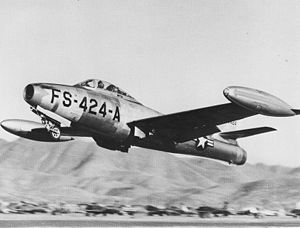 Picture: USAF F-84E Thunderjet
Picture: USAF F-84E Thunderjet
Role - Fighter-bomber
Manufacturer - Republic Aviation
Designed by - Alexander Kartveli
First flight - 28 February 1946
Introduced - November 1947
Primary user - United States Air Force
Number built - 7,524
Unit cost - US$237,247 (F-84G)[1]
US$769,330 (F-84F)
Variants - F-84F Thunderstreak
XF-84H Thunderscreech
XF-91 Thunderceptor
The Republic F-84 Thunderjet was an American turbojet fighter-bomber aircraft. Originating as a 1944 United States Army Air Forces proposal for a "day fighter", the F-84 flew in 1946. Although it entered service in 1947, the Thunderjet was plagued by so many structural and engine problems that a 1948 Air Force review declared it unable to execute any aspect of its intended mission and considered cancelling the program. The aircraft was not considered fully operational until the 1949 F-84D model and the design matured only with the definitive F-84G introduced in 1951. In 1954, the straight-wing Thunderjet was joined by the swept-wing F-84F Thunderstreak fighter and RF-84F Thunderflash photo reconnaissance aircraft.
The Thunderjet became the Air Force's primary strike aircraft during the Korean War, flying 86,408 missions and destroying 60% of all ground targets in the war as well as eight Soviet-built MiG fighters. Over half of the 7,524 F-84s produced served with NATO nations, and it was the first aircraft to fly with the U.S. Air Force Thunderbirds demonstration team. The USAF Strategic Air Command had F-84 Thunderjets in service from 1948 through 1957.
The F-84 was the first production fighter aircraft to utilize in-flight refueling and the first fighter capable of carrying a nuclear weapon, i.e. the Mark 7 nuclear bomb. Modified F-84s were used in several unusual projects, including the FICON and Tom-Tom dockings to the B-29 and B-36 bomber motherships, and the experimental XF-84H Thunderscreech supersonic turboprop.
The F-84 nomenclature can be somewhat confusing. The straight-wing F-84A to F-84E and F-84G models are called the Thunderjet. The F-84F Thunderstreak and RF-84F Thunderflash are a different airplane with swept wings. The XF-84H Thunderscreech was an experimental turboprop version of the F-84F. The F-84F swept wing version was intended to be a small variation on the normal Thunderjet with only a few different parts, so it kept the basic F-84 number. Production delays on the F-84F resulted in another order of the straight-wing version; this was the F-84G.
Design and development
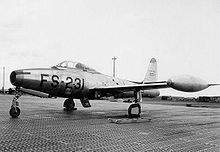 Picture: An F-84G at Chaumont Air Base, France, in 1953
Picture: An F-84G at Chaumont Air Base, France, in 1953
In 1944, Republic Aviation's chief designer, Alexander Kartveli, began working on a turbojet-powered replacement for the P-47 Thunderbolt piston-engined fighter. The initial attempts to redesign the P-47 to accommodate a jet engine proved futile due to the large cross-section of the early centrifugal compressor turbojets. Instead, Kartveli and his team designed a brand-new aircraft with a streamlined fuselage largely occupied by an axial compressor turbojet engine and fuel stored in rather thick unswept wings.[1]
On 11 September 1944, the United States Army Air Forces released General Operational Requirements for a day fighter with a top speed of 600 mph (521 kn, 966 km/h), combat radius of 705 miles (612 nmi, 1,135 km), and armament of either six 0.50 in (12.7 mm) or four 0.60 in (15.2 mm) machine guns. In addition, the new aircraft had to use the General Electric TG-180 axial turbojet which entered production as Allison J35.
On 11 November 1944, Republic received an order for three prototypes of the new XP-84—Model AP-23.[1] Since the design promised superior performance to the Lockheed-built P-80 Shooting Star and Republic had extensive experience in building single-seat fighters, no competition was held for the contract. The name Thunderjet was chosen to continue the Republic Aviation tradition started with the P-47 Thunderbolt while emphasizing the new method of propulsion. On 4 January 1945, even before the aircraft took to the air, the USAAF expanded its order to 25 service test YP-84As and 75 production P-84Bs (later modified to 15 YP-84A and 85 P-84B).
Meanwhile, wind tunnel testing by the National Advisory Committee for Aeronautics revealed longitudinal instability and stabilizer skin buckling at high speeds.[1] The weight of the aircraft, a great concern given the low thrust of early turbojets, was growing so quickly that the USAAF had to set a gross weight limit of 13,400 lb (6,080 kg). The results of this preliminary testing was incorporated into the third prototype, designated XP-84A, which was also fitted with a more powerful J35-GE-15 engine with 4,000 lbf (17.8 kN) of thrust.[1]
The first prototype XP-84 was transferred to Muroc Army Air Field (present-day Edwards Air Force Base) where it flew for the first time on 28 February 1946 with Major Wallace A. "Wally" Lien at the controls. It was joined by the second prototype in August; both aircraft flying with J35-GE-7 engines producing 3,745 lbf (16.66 kN). The 15 YP-84As delivered to Patterson Field (present-day Wright-Patterson Air Force Base) for service tests differed from XP-84s by having an upgraded J35-A-15 engine, carrying six 0.50 in (12.7 mm) M2 Browning machine guns (four in the nose and one in each wing root), and having the provision for wingtip fuel tanks holding 226 gal (870 l) each.
Due to delays with delivery of jet engines and production of the XP-84A, the Thunderjet had undergone only limited flight testing by the time production P-84Bs began to roll out of the factory in 1947. In particular, the impact of wingtip tanks on aircraft handling was not thoroughly studied. This proved problematic later.[1]
After the creation of the United States Air Force by the National Security Act of 1947, the Pursuit designation was replaced with Fighter, and the P-84 became the F-84.
F-84s were assigned to the 27th Fighter Wing, 27th Fighter Escort Wing, 27th Strategic Fighter Wing, 31st Fighter Escort Wing, 127th Fighter Day Wing, 127th Fighter Escort Wing, 127th Strategic Fighter Wing, 407th Strategic Fighter Wing and the 506th Strategic Fighter Wing of the Strategic Air Command from 1947 through 1958.[2]
Operational history
The F-84B, which differed from YP-84A only in having faster-firing M3 machine guns, became operational with 14th Fighter Group at Dow Field, Bangor, Maine in December 1947. Flight restrictions followed immediately, limiting maximum speed to Mach 0.8 due to control reversal, and limiting maximum acceleration to 5.5 g (54 m/s²) due to wrinkling of the fuselage skin. To compound the problem, parts shortages and maintenance difficulties earned the aircraft the nickname "Mechanic's Nightmare".[1] On 24 May 1948, the entire F-84B fleet was grounded due to structural failures.
A 1948 review of the entire F-84 program discovered that none of the F-84B or F-84C aircraft could be considered operational or capable of executing any aspect of their intended mission. The program was saved from cancellation because the F-84D, whose production was well underway, had satisfactorily addressed the major faults. A fly-off against the F-80 revealed that while the Shooting Star had a shorter takeoff roll, better low altitude climb rate and superior maneuverability, the F-84 could carry a greater warload, was faster, had better high altitude performance and greater range.[1] As a temporizing measure, the USAF in 1949 committed US$8 million to implement over 100 upgrades to all F-84Bs, most notably reinforcing the wings. Despite the resultant improvements, the F-84B was withdrawn from active duty by 1952.[1]
The F-84C utilized a somewhat more reliable J35-A-13 engine and had some engineering refinements. Being virtually identical to the F-84B, the C model suffered from all of the same defects and underwent a similar structural upgrade program in 1949. All F-84Cs were withdrawn from active service by 1952.[1]
The structural improvements were factory-implemented in the F-84D, which entered service in 1949. Wings were covered with thicker aluminum skin, the fuel system was winterized and capable of using JP-4 fuel, and a more powerful J35-A-17 engine with 5,000 lbf (22.2 kN) was fitted. It was discovered that the untested wingtip fuel tanks contributed to wing structural failures by inducing excessive twisting during high-g maneuvers.[1] To correct this, small triangular fins were added to the outside of the tanks. The F-84D was phased out of USAF service in 1952 and left Air National Guard service in 1957.[1]
The first effective and fully-capable Thunderjet was the F-84E model which entered service in 1949. The aircraft featured the J35-A-17 engine, further wing reinforcement, a 12 in (305 mm) fuselage extension in front of the wings and 3 in (76 mm) extension aft of the wings to enlarge the cockpit and the avionics bay, an A-1C gunsight with APG-30 radar, and provision for an additional pair of 230 gal (870 l) fuel tanks to be carried on underwing pylons.[1] The latter increased the combat radius from 850 mi (740 nmi, 1,370 km) to 1,000 mi (870 nmi, 1,610 km).
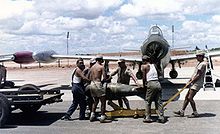 Picture: A Portuguese F-84 being loaded with ordnance in the 1960s, at Luanda Air Base, during the Portuguese Colonial War.
Picture: A Portuguese F-84 being loaded with ordnance in the 1960s, at Luanda Air Base, during the Portuguese Colonial War.
Despite the improvements, the in-service rates for the F-84E remained poor with less than half of the aircraft operational at any given time.[1] This was primarily due to severe shortage of spares for the Allison engines. The expectation was that F-84Es would fly 25 hours per month, accumulating 100 hours between engine overhauls. The actual flight hours for Korean War and NATO deployments rapidly outpaced the supply and Allison's ability to manufacture new engines.[1] The F-84E was withdrawn from USAF service in 1956, lingering with ANG units until 1959.
The definitive straight-wing F-84 was the F-84G which entered service in 1951. The aircraft introduced a refueling boom receptacle in the left wing, autopilot, Instrument Landing System, J35-A-29 engine with 5,560 lbf (24.7 kN) of thrust, and the ability to carry a single Mark 7 nuclear bomb.[1] The F-84G was retired from USAF in the mid-1960s.
Starting in the early 1960s, the aircraft was widely used by the Portuguese Air Force during the Portuguese Colonial War in Africa.
Flying the Thunderjet
Typical of most early jets, the Thunderjet's takeoff performance left much to be desired. In hot Korean summers with a full combat load, the aircraft routinely required 10,000 ft (3,000 m) of runway for takeoff even with the help of RATO bottles (two or four of these were carried, each producing 1,000 lbf (4.4 kN) of thrust for 14 seconds).[1] All but the lead aircraft had their visibility obscured by the thick smoke from the rockets. Early F-84s had to be pulled off the ground at 160 mph (140 kn, 260 km/h) with the control stick held all the way back. Landings were made at a similar speed (for comparison, the P-51 Mustang landed at approximately 120 mph (100 kn, 190 km/h). Despite the "hot" landing speeds, the Thunderjet was easy to fly on instruments and crosswinds did not present much of a problem.[3]
Thanks to the thick straight wing the Thunderjet rapidly reached its Mach 0.82 limitation at full throttle and low altitude. The aircraft had sufficient power to fly faster, but exceeding the Mach limit at low altitudes resulted in a violent pitch-up and structural failure causing the wings to break off.[3] Above 15,000 ft (4,600 m), the F-84 could be flown faster but at the expense of severe buffeting. Fortunately, the airspeed was sufficiently easy to control to make safe dive bombing from 10,000 ft (3,000 m) possible.[3] The top speed limitation proved troublesome against Soviet Mikoyan-Gurevich MiG-15s in Korea. Slower than the MiG, the F-84 was also unable to turn tightly with a maximum instantaneous-turn load of only 3 Gs followed by rapid loss of airspeed. One F-84E pilot credited with two MiG kills achieved his second victory by intentionally flying his aircraft into pitch-up.[3] The MiGs chasing him were unable to follow the violent maneuver and one crashed into the ground. Luckily for the pilot, the aircraft did not disintegrate but the airframe did suffer heavy warping. The F-84 was a stable gun platform and the computing gunsight aided in accurate gunnery and bombing. Pilots praised the aircraft for Republic's legendary ruggedness.[3]
Pilots nicknamed the Thunderjet "The Lead Sled".[2] It was also called "The Iron Crowbar", "a hole sucking air", "The Hog" ("The Groundhog"), and "The World's Fastest Tricycle" as a testament to its long takeoff rolls.[2] F-84 lore stated that all aircraft were equipped with a "sniffer" device that, upon passing V2, would look for the dirt at the end of the runway. As soon as the device could smell the dirt, the controls would turn on and let the pilot fly off the ground. In the same vein, it was suggested a bag of dirt should be carried in the front landing gear well. Upon reaching V2, the pilot would dump the dirt under the wheels, fooling the sniffer device.[2]
Korean War
The Thunderjet had a distinguished record during the Korean War. Although the F-84B and F-84C could not be deployed because their J35 engines had a service life of only 40 hours, the F-84D and F-84E entered combat with 27th Fighter Escort Group on 7 December 1950.[1] The aircraft were initially tasked with escorting the B-29 Superfortress bombers. The first Thunderjet air-to-air victory was scored on 21 January 1951 at the cost of two F-84s.[2] The F-84 was a generation behind the swept-wing Soviet Mikoyan-Gurevich MiG-15 and outmatched, especially when the MiGs were flown by Soviet pilots, and the MiG counter-air mission was soon given to the F-86 Sabre. Like its famous predecessor, the P-47, the F-84 switched to the low-level interdiction role at which it excelled.
The F-84 flew a total of 86,408 missions, dropping 55,586 tons (50,427 tonnes) of bombs and 6,129 tons (5,560 tonnes) of napalm.[2] The USAF claimed F-84s were responsible for 60% of all ground targets destroyed in the war. Notable F-84 operations included the 1952 attack on the Sui-ho Dam. During the war, the F-84 became the first USAF fighter to utilize aerial refueling. In aerial combat, F-84 pilots were credited with eight MiG-15 kills against a Soviet-claimed loss of 64 aircraft. The total losses were 335 F-84D, E and G models.[2]
Notable achievements
The F-84 was the first aircraft flown by the U.S. Air Force Thunderbirds, which operated F-84G Thunderjets from 1953 to 1955 and F-84F Thunderstreaks from 1955 to 1956. The F-84E was also flown by the Skyblazers team of United States Air Forces Europe (USAFE) from 1950 to 1955.[1]
On 7 September 1946, the second XP-84 prototype set a national speed record of 607.2 mph (527.6 kn, 977.2 km/h), a bit slower than the world record 612.2 mph (532.0 kn, 985.2 km/h) held by the British Gloster Meteor.[1]
On 22 September 1950, two EF-84Es, flown by David C. Schilling and Col. William Ritchie, flew across the North Atlantic from Great Britain to the United
States. Ritchie's aircraft ran out of fuel over Newfoundland but the other successfully made the crossing which took 10 hours 2 minutes and three aerial
refuelings. The flight demonstrated that large numbers of fighters could be rapidly moved across the Atlantic.[1]
F-84G was the first fighter with built-in aerial refueling capability and the first single-seat aircraft capable of carrying a nuclear bomb.[1]
On 20 August 1953, 17 F-84Gs utilizing aerial refueling flew from the United States to the United Kingdom. The 4,485 mi (3,900 nmi, 7,220 km) journey was the longest-ever nonstop flight by jet fighters.[1]
By the mid-1960s, the F-84/F-84F was replaced by the F-100 Super Sabre and the RF-84F by the RF-101 Voodoo in USAF units, being relegated to duty in the Air National Guard. The last F-84F Thunderflash retired from the ANG in 1971. Three Hellenic Air Force RF-84Fs that were retired in 1991 were the last operational F-84s.
Variants
Straight-wing variants
XP-84
- The first two prototypes.
XP-84A
- The third prototype with a more powerful J35-GE-15 engine.
YP-84A
- Service test aircraft; 15 built.
P-84B (F-84B)
- First production version, J35-A-15 engine; 226 built.
EF-84B
- Two F-84Bs converted into parasite fighters to be attached to the wingtips of an ETB-29 bomber as part of Project Tom-Tom.
F-84C
- Reverted to the more reliable J35-A-13 engine, improved fuel, hydraulic and electrical systems; 191 built.
F-84D
- J35-A-17 engine, various structural improvements. The pitot tube was moved from the tail fin to the splitter in the air intake with fins added to the
wingtip fuel tanks; 154 built.
 Picture: SFR Yugoslav Air Force F-84 Thunderjet during "Sloboda 71" (Freedom 71) military exercises.
Picture: SFR Yugoslav Air Force F-84 Thunderjet during "Sloboda 71" (Freedom 71) military exercises.
F-84E
- J35-A-17D engine, Sperry AN/APG-30 radar-ranging gunsight, fuselage stretched 12 in (30 cm) to enlarge the cockpit, retractable attachments for RATO
bottles, inboard wing hardpoints made "wet" to permit carrying an additional pair of 230 gal (885 l) fuel tanks. Can be distinguished from
earlier models by the presence of two fuel vents on ventral rear fuselage. Most aircraft were retrofitted with F-84G-style reinforced canopies; 843
built.
EF-84E
- Two F-84Es were converted into test prototypes, to test various methods of air-to-air refuelling.
F-84G
- Single-seat fighter-bomber capable of delivering the Mark 7 nuclear bomb using the LABS, J35-A-29 engine, autopilot, capable of in-flight refueling
using both the boom (receptacle in left wing leading edge) and drogue (probe fitted to wingtip fuel tanks), introduced the multi-framed canopy which
was later retrofitted to earlier straight-winged F-84s. A total of 3,025 were built (1,936 for NATO under MDAP).
EF-84G
- Zero length launch version for point defense, used the booster rocket from MGM-1 Matador cruise missile, did not enter production.
F-84KX
- Eighty ex-USAF F-84Bs converted into target drones for the United States Navy.
Swept-wing variants
YF-84F
- Two swept-wing prototypes of the F-84F, initially designated YF-96A.
F-84F Thunderstreak
- Swept wing version with Wright J65 engine.
RF-84F Thunderflash
- Reconnaissance version of the F-84F, 715 built.
RF-84K FICON project
- Reconnaissance version if the F model, 25 built to hang from the Consolidated B-36 Peacemaker.
XF-84H Thunderscreech
- experimental supersonic-turboprop version
YF-84J
- Two conversions with the General Electric J73 engine.
Operators
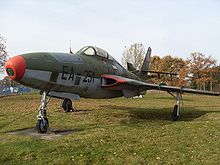 Picture: German RF-84F Thunderjet with 6 cameras in the closed nose
Picture: German RF-84F Thunderjet with 6 cameras in the closed nose
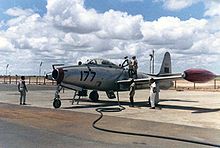 Picture: Portuguese Air Force F-84 Thunderjet.
Picture: Portuguese Air Force F-84 Thunderjet.
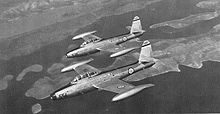 Picture: A pair of Yugoslav AF F-84 Thunderjets belonging to the 204th Aviation Regiment, flying over Kornati Islands, Croatia.
Picture: A pair of Yugoslav AF F-84 Thunderjets belonging to the 204th Aviation Regiment, flying over Kornati Islands, Croatia.
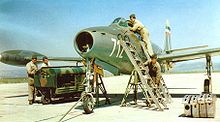 Picture: Yugoslav F-84 Thunderjet undergoing pre-flight check-up.
Picture: Yugoslav F-84 Thunderjet undergoing pre-flight check-up.
Major USAF Operational F-84 Units
10th Tactical Reconnaissance Wing: RF-84F (1955-1958)
12th Fighter Escort Wing/Group: F-84E/G/F (1950-1957;1962-1964)
14th Fighter Wing/Group: P/F-84B (1947-1949)
15th Tactical Fighter Wing: F-84F (1962-1964)
20th Fighter Bomber Wing/Group: F-84B/C/D/E/F (1958-1959)
27th Fighter Escort Wing/Group: F-84E/G/F (1950-1958)
31st Fighter Escort Wing/Group: F-84C/E/F (1948-1950; 1951-1957)
49th Fighter Bomber Wing/Group: F-84E/G (1951-1953)
58th Fighter Bomber Group: F-84E/G (1952-1954)
66th Tactical Reconnaissance Wing: RF-84F (1955-1959)
67th Tactical Reconnaissance Wing: (15th & 45th TRS5) RF-84F/K (1955-1958)
71st Strategic Reconnaissance Wing: RF-84F/K (1955-1956)
81st Fighter Bomber Wing/Group: F-84F (1954-1959)
312th Fighter Bomber Group: F-84E/G (1954-1955)
363rd Tactical Reconnaissance Wing: RF-84F (1954-1958)
366th Fighter Bomber Wing/Tactical Fighter Wing: F-84E,F (1954-1958;1962-1965)
401st Fighter Bomber Wing/Tactical Fighter Wing: F-84F (1957)
405th Fighter Bomber Wing/Tactical Fighter Wing: F-84F (1953-1956)
407th Strategic Fighter Wing: F-84F (1954-1957)
474th Fighter Bomber Wing: F-84D/E/G (1952-1953)
506th Strategic Fighter Wing: F-84F (1953-1957)
508th Strategic Fighter Wing: F-84F (1952-1956)
3540th Combat Crew Training Wing: F-84E (1952-1953)
3600th Combat Crew Training Wing: F-84D/E/G/F (1952-1957)
- Redesignated 4510th CCTW with F-84D/F (1958)
3645th Combat Crew Training Wing: F-84E/G (1953-1957)
4925th Test Group (Atomic): F-84E/F/G (1950-1963)
Specifications (F-84G Thunderjet)
Data from Encyclopedia of US Air Force Aircraft and Missile Systems[1]
General characteristics
Crew: 1
Length: 38 ft 1 in (11.60 m)
Wingspan: 36 ft 5 in (11.10 m)
Height: 12 ft 7 in (3.84 m)
Wing area: 260 ft² (24 m²)
Empty weight: 11,470 lb (5,200 kg)
Loaded weight: 18,080 lb (8,200 kg)
Max takeoff weight: 23,340 lb (10,590 kg)
Powerplant: 1× Allison J35-A-29 turbojet, 5,560 lbf (24.7 kN)
Performance
Maximum speed: 622 mph (540 kn, 1,000 km/h)
Cruise speed: 475 mph (413 kn, 770 km/h)
Range: 1,000 mi (870 nmi, 1,600 km) combat
Ferry range: 2,000 mi (1,700 nmi, 3,200 km) with external tanks
Service ceiling: 40,500 ft (12,350 m)
Rate of climb: 3,765 ft/min (19.1 m/s)
Wing loading: 70 lb/ft² (342 kg/m²)
Thrust/weight: 0.31 lbf/lb
Armament
6 x .50 in (12.7 mm) M3 Browning machine guns, 300 rpg
Up to 4,450 lb (2,020 kg) of rockets and bombs, including 1 x Mark 7 nuclear bomb
Avionics
A-1CM or A-4 gunsight with APG-30 or MK-18 ranging radar
On display
XP-84 (#476) (Forward fuselage and cockpit only) is on display at the National Air & Space Museum in Washington D.C..
YP-84A (fuselage only) is on display at the Planes of Fame Air Museum in Chino, California
F-84A (45-59494) is on display at the Octave Chanute Aerospace Museum in Rantoul, Illinois
F-84B (45-59504) is on display at the Cradle of Aviation Museum in Garden City, New York
F-84B (45-59554) is on display at the Pima Air Museum in Tucson, Arizona
F-84B (45-59566) is on display at the Planes of Fame, Grand Canyon Valle Museum at Williams Airport in Valle Williams, Arizona.
F-84C (47-1433) is on display at the Pima Air Museum in Tucson, Arizona
F-84C (47-1513) is on display at Kansas & Historical Air at McConnell Air Force Base in Wichita, Kansas
F-84C (47-1595) is on display at the March Field Air Museum in Riverside, California
F-84C (51-9456) is on display at the Experimental Aircraft Association Air Adventure Museum in Oshkosh, Wisconsin
F-84C is on display at the Cannon Airpark at Cannon Air Force Base in Clovis, New Mexico
F-84C is on display at the Ohio Air National Guard base in Springfield, Ohio
F-84D is on display at the Savannah Air National Guard base in Savannah, Georgia
F-84E (50-1143) is on display at the National Museum of the United States Air Force in Dayton, Ohio. It was obtained from Robins Air Force Base, Georgia, in October 1963[4]
F-84E (50-37543) is on display at the Heritage Park at Little Rock Air Force Base in Little Rock, Arkansas
F-84F (Tail number unknown) is on display at the campus of Enterprise-Ozark Community College, Ozark, AL.
F-84 is on display at the Delta County Airport in Escanaba, Michigan
RF-84F (37604) is on display at the OSU Air Force ROTC building in Stillwater, Oklahoma [1].
RF-84F (EA-251) is on display at the Fliegerhorst Schleswig, in Schleswig, Schleswig-Holstein, Germany
RF-84F (52-7468) is on display at Heraklion airbase, Greece
F-84G (DU-24) is on display at the Militair Luchtvaart Museum in Soesterberg, the Netherlands.
F-84G (Yugoslav registration: 10501/ex-52-2936) is on display at the at Yugoslav Aeronautical Museum, Nikola Tesla Airport, Belgrade, Serbia. [5]
F-84G (Yugoslav registration: 10530/ex-52-8435) is on display at the at Yugoslav Aeronautical Museum, Nikola Tesla Airport, Belgrade, Serbia. [5]
F-84G (Yugoslav registration: 10525/ex-52-2939) is on display at the at Yugoslav Aeronautical Museum, Nikola Tesla Airport, Belgrade, Serbia. [5]
F-84G on display (registration no. unconfirmed) at ROCAF Academy Museum, KangShan AFB, Taiwan.
F-84G on display (registration no. unconfirmed) at ROC Air Force Museum, TaiNan AFB, Taiwan.
F-84G on display (registration no. unconfirmed) serving as gate guard at ChiaYi AFB, Taiwan.
F-84G on display (Letters KR-A,registration unconfirmed) at Defence- & Garrison Museum, Aalborg, Denmark.
Related development
F-84F Thunderstreak
XF-84H Thunderscreech
XF-91 Thunderceptor
Comparable aircraft
Dassault Ouragan
de Havilland Venom
Gloster Meteor
Grumman F9F Panther
Grumman F9F Cougar
References
Notes
1. ^ a b c d e f g h i j k l m n o p q r s t u v w x y Knaack, Marcelle Size. Encyclopedia of US Air Force Aircraft and Missile Systems: Volume 1 Post-World
War II Fighters 1945-1973. Washington, DC: Office of Air Force History, 1978. ISBN 0-912799-59-5.
2. ^ a b c d e f g McLaren 1998
3. ^ a b c d e Higham, R. and Williams, C. Flying Combat Aircraft of USAAF-USAF (Vol.1). Rockville, Maryland: Air Force Historical Foundation, 1975.
ISBN 0-8138-0325-X.
4. ^ United States Air Force Museum (1975 edition)
5. ^ a b c Museum of Aviation in Belgrade
Bibliography
Bowers, Peter M. and Enzo Angellucci. The American Fighter. New York: Orion Books, 1987. ISBN 0-517-56588-9.
Donald, David and Jon Lake, eds. Encyclopedia of World Military Aircraft. London: AIRtime Publishing, 1996. ISBN 1-880588-24-2.
Forrer, F.The Fun of Flying. Hollands Glory, 1992. ISBN 0-9714490-3-1.
Keaveney, K. Republic F-84/Swept-Wing Variants (Aerofax Minigraph, No 15). London: Aerofax. 1987. ISBN 0-942548-20-5.
McLaren, David. Republic F-84 Thunderjet, Thunderstreak & Thunderflash: A Photo Chronicle. Atglen, PA: Schiffer Military/Aviation History, 1998.
ISBN 0-7643-0444-5.
Swanborough, Gordon and Peter Bowers. United States Military Aircraft Since 1909. Washington, DC: Smithsonian, 1989. ISBN 0-87474-880-1.
United States Air Force Museum Guidebook. Wright-Patterson AFB, Ohio: Air Force Museum Foundation, 1975.
Wagner, Ray. American Combat Planes, Third Enlarged Edition. New York: Doubleday, 1982. ISBN 0-385-13120-8.
Living Warbirds: The best warbirds DVD series.
Source: WikiPedia